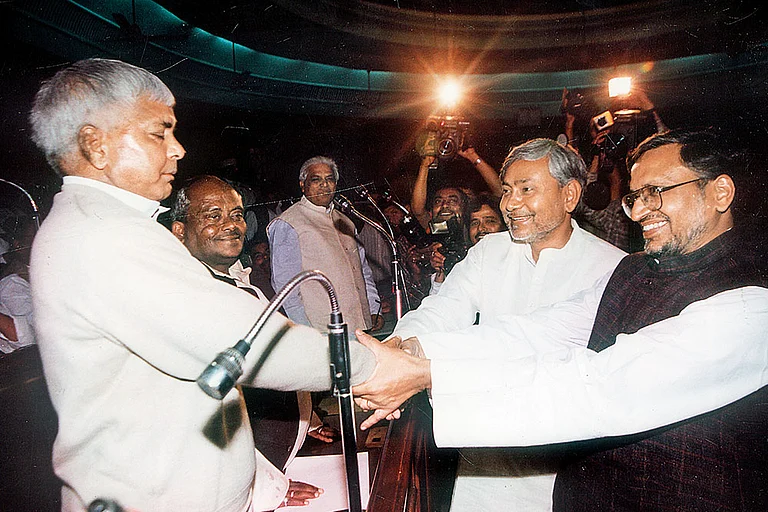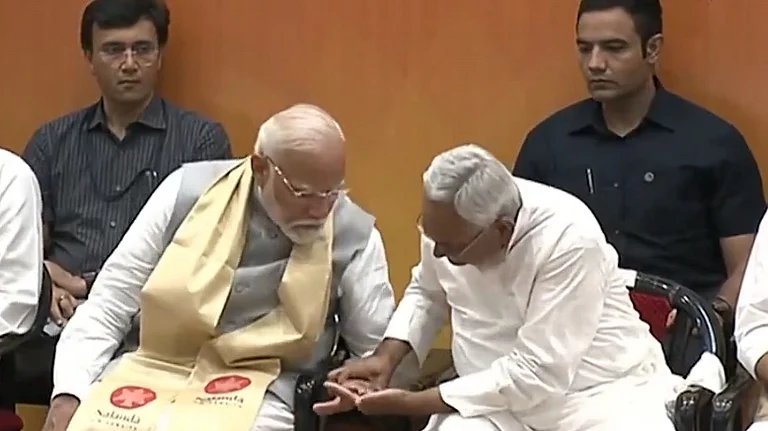All eyes are on Bihar Chief Minister Nitish Kumar whether he will ‘‘reinvent’’ himself as the people’s leader by exercising checks and balances on the Modi 3.0 government when needed or continue as Paltu Ram, a moniker he earned because of his frequent political flip-flops.
Will Nitish Kumar Reinvent Himself As The People’s Leader In The NDA Govt?
It will be interesting to see if Nitish Kumar will be in a position to apply the brakes on the Modi 3.0 government in the interest of the people when the need arises
People have given their mandate to the National Democratic Alliance (NDA), restricting the Bharatiya Janata Party (BJP) to 240 seats and also slowing the party’s juggernaut in the process. Now, Nitish (73), has a greater role to play as his party is a part of the government at the Centre and it will be interesting to see whether he will be in a position to apply the brakes if needed in the interest of the people and the nation, says a political observer.
The issue assumes more significance when one considers how the Rashtriya Swayamsevak Sangh (RSS) chief Mohan Bhagwat recently said that a true sevak (one who serves the people) does not have "ahankar" (arrogance) and works without causing any hurt to others.
While addressing a gathering of RSS leaders and trainees in Nagpur, Bhagwat was equally unsparing as he pointed out, “Manipur has been waiting for peace for a year. Before this, it was peaceful for 10 years. It seemed that the old gun culture had ended...And suddenly the conflict that was created or instigated there is still burning…it is crying for help. Who will pay attention to this? It is our duty to consider it on a priority basis.”
If this was not enough, RSS national executive member Indresh Kumar while speaking at the Ramrath Ayodhya Yatra Darshan Poojan Samaroh at Kanota near Jaipur declared, "The party which did the bhakti (of Lord Ram) but became arrogant was stopped at 240 but it was made the biggest party."
With the BJP’s seat tally falling short of a simple majority by 32 seats, the importance of its allies–particularly the Janata Dal United JD (U) and the Telugu Desam Party (TDP)–has increased manifold. The TDP’s 16 MPs and the JD (U)’s 12 are crucial for the survival of the new government at the Centre.
In the given situation, Nitish, known for his on and off relationship with the BJP, is now the man of the moment. His every ‘‘action and also inaction’’ will be closely watched and analysed.
Pushpendra Kumar Singh, former Professor of the Tata Institute of Social Sciences, says, “I think that Nitish’s importance in national politics will only to grow in times to come, particularly when the RSS has also started targeting the BJP leadership over the party not performing as expected.” Singh does not expect Nitish to take any drastic decision on ideological issues, recalling how the JD (U) had supported the Citizenship (Amendment) Bill in the Lok Sabha and the Rajya Sabha. “Unless the Modi-led NDA government takes some contentious decisions targeting Nitish’s core constituency, including Muslims, the JD (U) leader will exercise restraint in taking any step that could cast a shadow on the present dispensation,” he says.
Professor Singh expects Nitish would instead exert pressure on the BJP to concede his demand of dissolving the State assembly and holding fresh elections as he wants to improve his party’s numerical strength in the lower house. He will also be seeking more funds and financial packages from the Centre to implement his schemes before he faces assembly election.
“Nitish’s challenge is how to protect his party MPs from any poaching attempt by the BJP. If he succeeds in it, he is poised to play a much bigger role in the future in national politics. It is also true that Nitish is hurt over his party not getting respect in the distribution of portfolios among Union ministers but he is not going to take it easy,” Professor Singh adds.
A Resurgent Man
It is not for the first time that Nitish has re-emerged stronger as in the past too those writing him off have been proved wrong. His political strategy kept him afloat in State politics and despite his flip-flops, his personal image is dented but not completely in tatters. Nitish’s base vote
bank rallied behind him despite his changing allegiances, and this is why whether it is the NDA or the Mahagathbandhan, the side the JD (U) leader is on gets stronger.
People had started discussing his health after the incoherent speeches he made during the Lok Sabha campaign, but the election results proved them wrong.
Professor Singh says, “Nitish’s voters are not concerned about his bloopers and his geriatric problems, and they are with him as long as he is physically present among them. This is why the JD (U) fared comparatively better than the BJP in the election.”
Senior journalist and political analyst Pushya Mitra said that Nitish had cultivated a strong constituency of EBCs, women and reached out to Dalits and Muslims by appointing them as Tola Sevaks and Talimi Markaz more effectively. Similarly, he created a strong pool of Jeevika Didis (around 1.31 crore), strengthening his popularity among women.
Nitish, who is a veteran socialist and a prominent product of the JP Movement of 1974-75, has seen several highs and lows in his political career. He had snapped ties with the Mahagathbandhan in January this year and formed a new government with the BJP.
Nitish has switched sides four times in just over a decade but still both the Mahagathbandhan and the NDA value his political clout. It is interesting that the Rashtriya Janata Dal (JDU) has started wooing him afresh after the formation of the NDA government at the Centre. He is now the longest serving chief minister of Bihar and apparently eyeing another term as CM.
His spectacular rise in politics is significant in more than one sense as his Kurim caste constitutes only three percent of the State’s population. So unlike other regional satraps like Lalu Prasad Yadav and Mulayam Singh Yadav, the vote base of his own caste is very limited. Before forming the Samata Party (SP) in 1994 with veteran politician George Fernandes, Nitish worked under the shadow of Lalu Prasad Yadav, now the RJD president.
The SP contested the 1995 state assembly election and fielded candidates in 310 out of total 324 seats of undivided Bihar but had to contend with only seven seats. A number of political observers at that time thought Nitish would never be able to make a mark in politics but he proved everybody wrong.
Bipolar Politics
After the SP’s rout in the 1995 assembly election, Nitish realised that his party would not be voted to power until State politics became bipolar. So, he made a smart move by joining hands with the BJP in 1996 when stalwarts like Atal Bihari Vajpayee and L K Advani were at the helm. In the 2000 assembly election, he was sworn in as chief minister but he resigned before the floor test as the NDA could not muster a majority. He became chief minister in the 2005 election held in October-November as the NDA finally ousted the RJD from power. He has been sharing power with the BJP since 2005 except twice (June 2013-July 2017) and about one-and-half years (August 2022-January 27, 2024) that he aligned with the RJD-led grand alliance.

